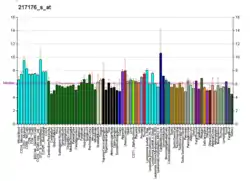ZFX
Zinc finger X-chromosomal protein is a protein that in mammals is encoded by the ZFX gene of the X chromosome.[5]
Function
This gene on the X chromosome is structurally similar to a related gene on the Y chromosome. It encodes a member of the krueppel C2H2-type zinc-finger protein family. The full-length protein contains an acidic transcriptional activation domain (AD), a nuclear localization sequence (NLS) and a DNA binding domain (DBD) consisting of 13 C2H2-type zinc fingers. Studies in mouse embryonic and adult hematopoietic stem cells showed that this gene was required as a transcriptional regulator for self-renewal of both stem cell types, but it was dispensable for growth and differentiation of their progeny. Multiple alternatively spliced transcript variants encoding different isoforms have been identified, but the full-length nature of some variants has not been determined. [provided by RefSeq, May 2010]
References
- GRCh38: Ensembl release 89: ENSG00000005889 - Ensembl, May 2017
- GRCm38: Ensembl release 89: ENSMUSG00000079509 - Ensembl, May 2017
- "Human PubMed Reference:". National Center for Biotechnology Information, U.S. National Library of Medicine.
- "Mouse PubMed Reference:". National Center for Biotechnology Information, U.S. National Library of Medicine.
- "Entrez Gene: ZFX zinc finger protein, X-linked".
Further reading
- North M, Sargent C, O'Brien J, et al. (1991). "Comparison of ZFY and ZFX gene structure and analysis of alternative 3' untranslated regions of ZFY". Nucleic Acids Res. 19 (10): 2579–86. doi:10.1093/nar/19.10.2579. PMC 328173. PMID 2041734.
- Mardon G, Luoh SW, Simpson EM, et al. (1990). "Mouse Zfx protein is similar to Zfy-2: each contains an acidic activating domain and 13 zinc fingers". Mol. Cell. Biol. 10 (2): 681–8. PMC 360866. PMID 2105457.
- Palmer MS, Berta P, Sinclair AH, et al. (1990). "Comparison of human ZFY and ZFX transcripts". Proc. Natl. Acad. Sci. U.S.A. 87 (5): 1681–5. doi:10.1073/pnas.87.5.1681. PMC 53546. PMID 2308929.
- Müller G, Schempp W (1989). "Mapping the human ZFX locus to Xp21.3 by in situ hybridization". Hum. Genet. 82 (1): 82–4. doi:10.1007/BF00288279. PMID 2497060.
- Schneider-Gädicke A, Beer-Romero P, Brown LG, et al. (1989). "ZFX has a gene structure similar to ZFY, the putative human sex determinant, and escapes X inactivation". Cell. 57 (7): 1247–58. doi:10.1016/0092-8674(89)90061-5. PMID 2500252.
- Schneider-Gädicke A, Beer-Romero P, Brown LG, et al. (1990). "Putative transcription activator with alternative isoforms encoded by human ZFX gene". Nature. 342 (6250): 708–11. doi:10.1038/342708a0. PMID 2512506.
- Taylor DM, Ray PF, Ao A, et al. (1998). "Paternal transcripts for glucose-6-phosphate dehydrogenase and adenosine deaminase are first detectable in the human preimplantation embryo at the three- to four-cell stage". Mol. Reprod. Dev. 48 (4): 442–8. doi:10.1002/(SICI)1098-2795(199712)48:4<442::AID-MRD4>3.0.CO;2-Q. PMID 9364438.
- Murphy WJ, Eizirik E, Johnson WE, et al. (2001). "Molecular phylogenetics and the origins of placental mammals". Nature. 409 (6820): 614–8. doi:10.1038/35054550. PMID 11214319.
- Agate RJ, Choe M, Arnold AP (2004). "Sex differences in structure and expression of the sex chromosome genes CHD1Z and CHD1W in zebra finches". Mol. Biol. Evol. 21 (2): 384–96. doi:10.1093/molbev/msh027. PMID 14660691.
- Poloumienko A (2004). "Cloning and comparative analysis of the bovine, porcine, and equine sex chromosome genes ZFX and ZFY". Genome. 47 (1): 74–83. doi:10.1139/g03-099. PMID 15060604.
- Beausoleil SA, Jedrychowski M, Schwartz D, et al. (2004). "Large-scale characterization of HeLa cell nuclear phosphoproteins". Proc. Natl. Acad. Sci. U.S.A. 101 (33): 12130–5. doi:10.1073/pnas.0404720101. PMC 514446. PMID 15302935.
This article incorporates text from the United States National Library of Medicine, which is in the public domain.








